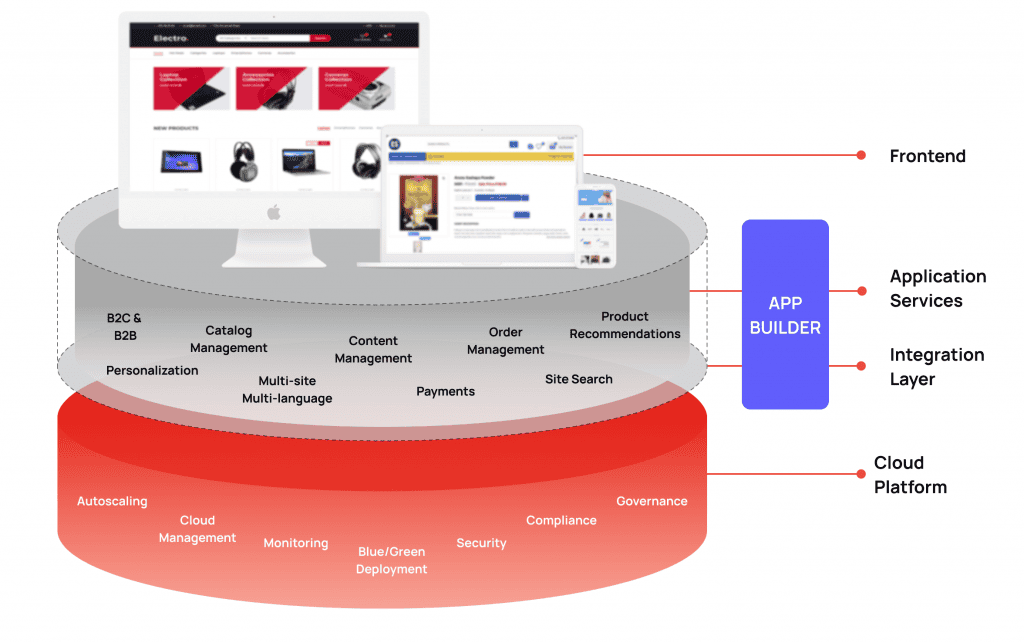Ah, ecommerce—it’s a jungle out there. When you started, did you have any idea that the needs of your customers could evolve so fast?
Doing ecommerce can feel like a constant (and costly) race to keep up with what digital shoppers need to see to make it to the finish line. And with so many shoppers out there…how can one storefront convince them all?
That’s where Adobe Commerce, formerly known as Magento Commerce Cloud, shines. If you’re here, you’ve likely heard about the platform in passing. But we’re going to give you more than a passing look at what it can do to rapidly scale your business.
What is Magento Commerce Cloud?
Magento Commerce on Cloud, now known as Adobe Commerce, is a cloud-hosted SaaS solution that enables large B2B and B2C businesses to build remarkable personalized shopping experiences for their customers.
Let’s take a moment to examine the evolution of this software; its origins and the changes it has undergone. This will help you understand the Adobe Commerce Cloud vs Magento dynamics.

Magento began in 2008 as open-source software for small businesses (Magento Community Edition), which developers could customize for their needs.
In 2009, the paid version called Magento Enterprise Edition appeared on the market with an extended suite of capabilities for large businesses. In 2017, these two separate software products were renamed:
- Magento Community Edition became Magento Open Source. This version of the platform is still supported and developed by the developers’ community.
- Magento Enterprise Edition (both self-hosted and cloud-based) became Magento Commerce.
Magento Commerce was acquired by Adobe in 2018. This acquisition set it on a path of integration into the Adobe Experience Cloud and was followed by rebranding to Adobe Magento Commerce, and gradually to the name it goes by today: Adobe Commerce.
The current Adobe’s proprietary version maintains what made the original ecommerce platform so powerful. On top of that, it continues to evolve beneath Adobe’s umbrella to meet the needs of large businesses even better.
Adobe Commerce Cloud Architecture
In terms of architecture, Adobe Commerce on Cloud consists of four main environments within which your development teams can expect to work. These environments are as follows:
- Master environment: This is where the core code of your site is stored, and where developers can work on continuous tests and bug fixes on this main branch of code without affecting the live site.
- Production environment: This is the live version of your site visible to end users (your customers).
- Integration environment: This is where your development team will build and test new features or changes to the site specifically.
- Staging environment: This is where your various teams will preview the new version of the site before it becomes live, assessing it holistically for issues.
Alongside a core architecture designed to encourage continuous testing and iteration, the platform also boasts the benefits of cloud nativity.
Being a cloud-hosted software, Adobe Commerce is capable of dynamic scalability when your site is bustling, and eliminates the possibility of downtime in these instances.
Without getting too in the weeds, we’ll say that the platform can promise these perks through redundant architecture—meaning that each of the software’s three production instances permit both reading and writing functionality at the same time. Put simply, if you’re making changes or updates to your site, it can still deliver experience to users without interruption.

Adobe Commerce Cloud Pricing
We know the biggest question on most businesses’ minds when considering Adobe Commerce: How much is it?
Like with many Adobe products for businesses, the pricing for this solution isn’t necessarily clear-cut, and will heavily rely on your business needs.
The software is licensed on a year-by-year basis. In this case, you can expect your price to fluctuate depending on your Gross Merchandise Value (GMV). It refers to the total amount of revenue a company generates within a specified period, such as quarterly or annually.
So, while we can’t give an exact estimate for you specifically, we can say that this ecommerce powerhouse is a considerable investment for your business. While it is an incredibly effective tool for any business, it might not be a sustainable investment (yet) for businesses with lower or startup revenue streams.
Adobe Commerce Cloud Features
Adobe Commerce Cloud puts an extensively long list of amazing features at your fingertips. All of these features work to create more intuitive and frictionless customer experiences within your storefront—which is, of course, the software’s biggest draw.
For our purposes here, we’ll focus on the cornerstone features that every business should have on their radar out of the gate. These features fall into four major categories, which we’ll look at below.
Shopping Enablement
Adobe Commerce Cloud’s shopping enablement features make it easier, faster, and more convenient for shoppers to make it to the point of sale via your storefront. Some of the cornerstone features here are as follows:
- Payment services dashboard: Secure payment data management in one spot.
- Headless commerce feature: Faster, more flexible experience design.
- Channel Management: Integrate with Walmart Marketplace easily.
- Amazon Sales: Integrate with Amazon to sell and fulfill there.
- Password-free checkout: Faster, mobile-optimized checkout for easier purchases.
- App-like mobile storefronts: Smooth out and speed up the path to sale on mobile.
- Manage multiple brands: One platform for all your brands or customers.
- Adobe Commerce B2B features: Create self-serve experiences, custom catalogs, and more.
End-User Personalization and Management
One of Adobe Commerce Cloud’s strongest perks is the ability to customize and personalize your storefront toward the unique needs of each user. Some key personalization features include:
- Omnichannel fulfillment: Enhance customer convenience with multiple fulfillment options.
- Limitless page building: Push new content with or without a developer.
- Smart search results: AI-enabled search results get users to what they need faster.
- Recommendations: Automatically show relevant product recommendations to users with AI intelligence.
- Intuitive UX: Built to be an efficiency driver for any team, with or without IT support.
- Real-time inventory: Show only what’s available when it’s available.
- Catalog Service: Get users the product and category info they need at lightning speed.
- Customer account management: Keep your customer service team up-to-date with a centralized source of truth.
- PWA Studio: Improve load speeds on mobile with responsive mobile-first design tools.
Visualize, Learn, and Grow
Of course, Adobe Commerce solutions wouldn’t be complete without a way to report and learn from the various iterations of your storefront. And especially when you’re creating personalized experiences, or globalizing your efforts, robust reporting is a must. Here’s some of what it has to offer on that front:
- Reporting tools: Visualize your data in customizable, unlimited dashboards.
- Real-time business intelligence: Centralize your eComm data and build custom reports.
Scalability and Innovation
Whenever your business grows, changes, or endeavors to customize experiences, you’ll need to know that your ecommerce solution is up for the task. Thankfully, the platform has a laundry list of incredible features to ensure that it scales as you do, and adapts to your custom needs. Among these features are:
- Cloud-native power: Always-current software, top-tier security, and no downtime.
- Data warehouse: Store all data in one place, and sync from multiple systems in one place.
- AWS-enabled environment and CDN: Ensure your storefront can scale with your business, no matter the size.
- Sensitive data protection: Deliver secure experiences through a Level 1, PCI-certified solution provider.
- Extend and customize: Use the commerce marketplace to find extensions, connectors, and themes that minimize friction-to-sale.
Integrate ERP systems: Reduce errors from manual data entry and sync your ERP to simplify orders, data, and shipping.
Adobe Commerce Cloud Benefits
Now that we’ve looked at some of the features Adobe Commerce has to offer, it’s probably getting clearer why it’s the ecommerce platform that businesses of all sizes dream about. Features aside, let’s go ahead and distill what’s great about it:
- Never down: Test, iterate, and update your storefront with no site downtime due to a redundant architecture model made possible by cloud-nativity.
- No hardware dependence: The platform doesn’t rely on your company hardware’s capability to run the software because it’s hosted on Adobe’s cloud servers.
- Always up-to-date: Receive new platform versions and updates instantly, with no downtime.
- Grows with you: Gain effortless scalability that can handle any level of globalization, nationalization, or personalization across multiple storefronts.
- All ecommerce experiences in one place: Centralized dashboards for all your active storefronts.
- Personalization and convenience: Build experiences with a wealth of personalization and convenience features, some powered by AI, that help smooth out the customer journey-to-sale.
Faster, and better for mobile: The platform ensures your site loads in a snap, never forcing you to sacrifice sales to a buffer wheel, and enables app-like mobile experiences.
Conclusion
For many large businesses, Adobe Commerce (formerly also called Magento Commerce Cloud) is likely the next evolution in sales growth. Designed for ecommerce fluidity, functionality, and scalability, it’s a world-class leader in online storefront design and management.
Now, you’re an expert on the features that the software brings to the table, and you know exactly how it makes strides for businesses like yours worldwide. But what we haven’t covered yet is something you’ll have to take into consideration—the migration to the platform itself.
You might be ready to evolve with Adobe Commerce, but your in-house teams might not be prepared to tackle that task just yet—and that’s perfectly fine. You can still make a migration happen with help from trained implementation experts, and ours are standing by to help answer questions about the process. Why not learn more?
FAQ
Who Should Choose Magento Commerce Cloud?
Magento Commerce Cloud is best for enterprise businesses that need future-proof scalability, limitless customization, and intelligent personalization options for their ecommerce business to thrive to its fullest.
What is the difference between Magento 2 and Adobe Commerce Cloud?
Magento 2 is an open-source, free-to-use version of the software that’s fully customizable. Being open source, it relies on developers to shape the software how they need it. Magento 2 also needs to be hosted locally.
Adobe Commerce Cloud is powered by Magento but is a paid, more robust version of the software intended for enterprise-level businesses. It comes with a lot more out-of-the-box features, enhanced security, and Adobe cloud hosting.
What does Adobe Commerce Cloud cost?
Pricing for the cloud version of the platform fluctuates in tiers depending on your Gross Marketplace Value (GMV). The estimated low-end cost to license the software for one year is around $40,000.
Is Adobe Commerce the same as Magento?
Yes, Adobe Commerce is essentially the same as Magento. The software was called Magento Commerce Cloud up until 2021 when it was rebranded under the Adobe umbrella.


